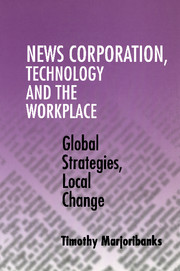Book contents
- Frontmatter
- Contents
- List of Tables and Figures
- Acknowledgements
- Abbreviation
- Introduction: Tales from the Workplace
- Part I Technological Innovation and Workplace Reorganisation: The Newspaper Industry
- 1 Global Technology and the Local Workplace: A Theoretical Debate
- 2 The Institutional and Societal Context: Britain, Australia and the United States
- 3 The Newspaper Industry: Historical Developments in the Three Countries
- Part II Technological Innovation and Workplace Reorganisation: News Corporation
- Bibliography
- Index
2 - The Institutional and Societal Context: Britain, Australia and the United States
Published online by Cambridge University Press: 04 August 2010
- Frontmatter
- Contents
- List of Tables and Figures
- Acknowledgements
- Abbreviation
- Introduction: Tales from the Workplace
- Part I Technological Innovation and Workplace Reorganisation: The Newspaper Industry
- 1 Global Technology and the Local Workplace: A Theoretical Debate
- 2 The Institutional and Societal Context: Britain, Australia and the United States
- 3 The Newspaper Industry: Historical Developments in the Three Countries
- Part II Technological Innovation and Workplace Reorganisation: News Corporation
- Bibliography
- Index
Summary
From the 1970s to the 1990s important developments occurred in the institutions and social, political and economic spheres in Britain and the United States that would enable employers to institute workplace reorganisation in the newspaper industry at the expense of union power. Both Britain and the United States have histories of strong union movements in the newspaper industry, however, by the end of the 1980s those unions had been severely weakened. At the same time, extensive reorganisation also occurred in the Australian newspaper industry, and yet unions continued to have a voice in negotiations over workplace reform. This chapter asks what occurred in the institutional and societal contexts of Britain and die United States for newspaper management to emerge into the 1990s in a position where they could operate almost independently of unions. And why did workplace reorganisation follow a different path in Australia?
The relational model, which provides die theoretical framework for this study, suggests that in order to understand die reorganisation of workplace relations associated with die introduction of new technology it is necessary to consider the institutions and the political, social and economic contexts in which die actors are situated. This chapter examines the specific contexts of Britain, Australia and the United States from the 1980s to the 1990s. It will show that although die three countries have much in common, their specific situations regarding workplace relations are quite different, and this had an important effect on how technological innovation occurred in die strongly unionised newspaper printing industry in each country.
- Type
- Chapter
- Information
- News Corporation, Technology and the WorkplaceGlobal Strategies, Local Change, pp. 27 - 56Publisher: Cambridge University PressPrint publication year: 2000



